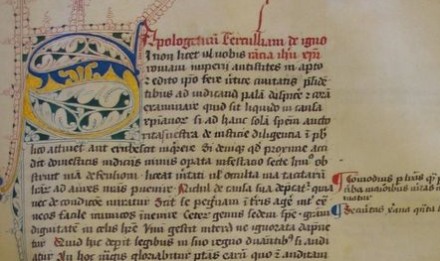Christian-History.org does not receive any personally identifiable information from the search bar below.
What Are Primary Sources?
How Do They Apply to Christian History?
What are primary sources?
Ad:
Our books consistently maintain 4-star and better ratings despite the occasional 1- and 2-star ratings from people angry because we have no respect for sacred cows.
Primary sources are historical documents written by someone who was there.
You can learn something about the churches of Antioch and Smyrna by reading a good church history book. However, the author of the church history book wasn't there. He had to read or study something in order to learn about those churches.
 Codex Balliolensis, from a writing by Tertullian
Codex Balliolensis, from a writing by TertullianPublic domain image
Primary sources are those things that the historian studied to learn about those churches. In the case of Antioch and Smyrna, primary sources would include Polycarp's letter to the Philippians because Polycarp was bishop of Smyrna. It would especially include Ignatius' letters to Smyrna and Polycarp (2 separate letters) because Ignatius was bishop of Antioch.
So now you know what are primary sources. Christians are not familiar enough with them!
Let me give you an important example.
The Council of Nicea
There are all sorts of myths floating around the internet about the Council of Nicea. One especially popular one is that the Council of Nicea determined the canon (which books should be included in Scripture). People interested in reviving gnosticism have promoted this myth, claiming that gnostic writings were accepted in the churches until the bishops at Nicea, led by the emperor Constantine, rejected them.
None of this is true, but how are you going to know that?
The secondary sources disagree. The secondary sources would be modern historians. For example, mainline scholars like Justo Gonzalez would reject the entire gnostic scenario, knowing that gnostic writings were never part of any church's canon of Scripture. Others, like Elaine Pagels, a woman who entirely invents her own history, claim otherwise.
How do you decide when the secondary sources disagree?
You consult the primary sources.
What are the primary sources for the Council of Nicea,? Well, we have their list of "canons," which are the 20 official decisions they made at the Council. None of those involve which books should be in Scripture. We also have the letter that the Council of Nicea sent to the churches, which is preserved by Eusebius, who was at the council.
There is also an eye-witness account by Athanasius, written much later.
All these primary sources agree, and primary sources carry the day. Secondary sources that can't back up their findings with primary sources are to be dismissed.
Primary Sources and the Study of Christian History
Primary sources are amazingly available and easy to use for the Christian who's interested in what the apostles' churches were like. The writings from the first hundred years after the apostles died comprise a volume about 3 times larger than the New Testament. On major issues—and on what the major issues were—there is no doubt what legacy the apostles left to the churches.
And those writings are available to anyone. Ever since the Church of England translated most of them in the late 1800's, they've been available through any Christian bookstore.
Today, you can order them online in many forms. Each individual writing is introduced, telling you—from good primary sources—how we know what we know about the writing, where it was found, and how it came down to us.
You can find the most inexpensive and useful versions of those on my recommended books page. It helps support our site as well.
So now you know the answer to what are primary sources!
You could have come to this page from many pages on this site. Please hit your back button to return to the page you were on.
Early Church History Newsletter
You will be notified of new articles, and I send teachings based on the pre-Nicene fathers intermittently.
When you sign up for my newsletter, your email address will not be shared. We will only use it to send you the newsletter.
